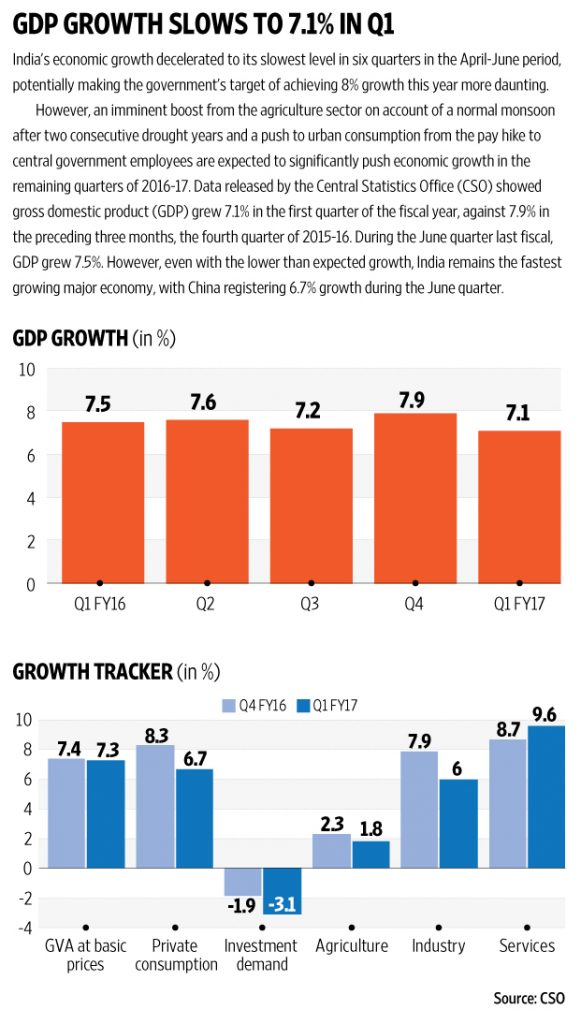
New Delhi: India’s economic growth decelerated to its slowest level in six quarters in the April-June period, potentially making the government’s target of achieving 8% growth this year more daunting.
However, an imminent boost from the agriculture sector on account of a normal monsoon after two consecutive drought years and a push to urban consumption from the pay hike to central government employees are expected to significantly push economic growth in the remaining quarters of 2016-17.
Data released by the Central Statistics Office (CSO) showed gross domestic product (GDP) grew 7.1% in the first quarter of the fiscal year, against 7.9% in the preceding three months, the fourth quarter of 2015-16.
During the June quarter last fiscal, GDP grew 7.5%.

The median forecast of 40 economists polled by Reuters projected GDP to grow 7.6% in the June quarter. However, even with the lower than expected growth, India remains the fastest growing major economy, with China registering 6.7% growth during the June quarter.
Another measure of economic activity—gross value added (GVA)—showed the economy growing at 7.3% in the June quarter, higher than the GDP growth rate.
GDP growth is arrived at by adding net indirect taxes (indirect taxes–subsidies) to GVA. A higher GVA in the June quarter means the government’s subsidies were higher than indirect tax collections in the quarter.
Reacting to the GDP data, economic affairs secretary Shaktikanta Das said he hopes the economy will clock nearly 8% growth during 2016-17.
“Last year, we achieved 7.6% growth on the back of failure of two monsoons. This year, the monsoon rains have been good. Agricultural production is expected to be much better than the previous two years and definitely agriculture will contribute significantly to GDP. Besides, the budget has been very well received by various sectors of the economy. A large number of structural reform measures have been taken by the government over the last two years, which are now beginning to be felt. All things put together, we are hoping to better last year’s growth rate and perhaps get closer to 8%,” he added.
While India remains overwhelmingly a consumption story, with private consumption contributing 55% of GDP, the segment grew 6.7% in the June quarter, compared with 8.3% in the March quarter.
Gross fixed capital formation, which is used as a proxy for investment demand in the economy, continued to contract, by 3.1% in the June quarter against a dip of 1.9% during the March quarter, signalling no pick-up in private investment activity in the economy.
Reserve Bank of India (RBI), in its annual report released on Monday, said while a durable pick-up in investment activity remains elusive, consumption will continue to provide the main support to aggregate demand and may receive a boost from the revival of rural demand in response to the above-normal and spatially well-distributed south-west monsoon as well as from the Seventh Pay Commission’s award.
Rating agency Crisil Ltd’s chief economist D.K. Joshi said investment continues to fall despite government pushing public investment.
“This is due to excess capacity in the private sector and a high level of debt in sectors such as construction and infrastructure. For investment to pick up, consumption recovery has to be sustainable for a long period of time,” he added.
What dragged down growth in the June quarter was the disappointing performance of industry, especially mining (–0.4%) and construction (1.5%). During the same quarter a year ago, the two sectors had grown 8.5% and 4.5%, respectively. This could be explained by the timely arrival of the monsoon, unlike last year.
Pre-empting a deceleration in the labour-intensive construction sector, the government earlier in the day announced a slew of measures to provide liquidity to the debt-ridden sector to allow completion of stalled projects.
Manufacturing (9.1%) and electricity (9.4%) sectors however performed better than they did during the same quarter a year ago when they grew at 7.3% and 4%, respectively.
Though it was clearly too early for the normal monsoon to find reflection in the June quarter data, a slowdown in the agriculture sector to 1.8% from 2.6% during the same quarter a year ago came as a surprise. CSO, in the press statement, attributed this to a fall in production of rice, coarse cereals and pulses during the rabi (winter crop) season. However, one segment within the agriculture sector—livestock products, forestry and fisheries—that contributes 42% to the sector, grew 3.7% during the June quarter.
The services sector received a boost from the front-loading of expenditure by the central government in the June quarter, helping it grow 12.3%, from 5.9% during the same quarter a year ago. Fresh data from the Controller General of Accounts released on Wednesday showed a slight moderation in spending in July, with the central government’s total expenditure during the April-July period at 33.2%, against 33.8% during the same period a year ago. The government exhausted 73.7% of its fiscal deficit target during the four months to July against 69.3% during the same period last year.
Among the other services sectors, while financing and real estate sector maintained steady growth of 9.4% in the June quarter against 9.3% a year ago, trade, hotels and transport sector decelerated to 8.1% from 10% a year ago.
Anis Chakravarty, lead economist at Deloitte India, said the latest GDP number showed that growth was still coming from a few parts of the economy and is yet to achieve a sustainable mix.
“Consumption is likely to show higher numbers in the coming quarters as the positive effect of the monsoon rains takes hold. Growth will likely get a boost from consumption in the second half due to a pick-up in rural consumption, helping the industry in some part. We stick to our forecast of growth around the 7.6% handle, which essentially means that any acceleration from the previous year is likely to be minimal,” he added.